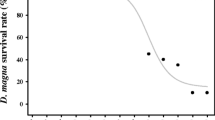Abstract
The naphthoquinone derivative, NQ 40, has been confirmed to be an effective algicide for controlling freshwater Microcystis blooms at the microcosm and mesocosm scales. Thus, in order to determine whether this algicide can control cyanobacterial blooms in the field, larger-scale mesocosms (50 t) and test beds (3,000 t) were tested. In the mesocosm and test-bed experiments, NQ 40 was effective and selective for algicidal activity against the target cyanobacteria (Microcystis spp.). In addition, the algicidal activity of NQ 40 gradually increased until days 8 and 30, while the algal biomass decreased by 96.7 and 100%, respectively. Ecosystem health improved due to the algicidal effect of NQ 40. In the test-bed experiment, the Shannon–Wiener diversity index of phytoplankton was significantly enhanced and the unbalanced ecological pyramid caused by cyanobacterial blooms was restored in the NQ 40 treatment. Although a few factors (pH, dissolved oxygen, and phosphate) associated with phytoplankton abundance exhibited different patterns between the control and treatments, the dynamics of abiotic factors in the treatments generally showed similar trends to the control. Therefore, NQ 40 could be a promising eco-friendly algicidal substance for restoring freshwater ecosystems damaged by cyanobacterial blooms.







Similar content being viewed by others
References
Afsar A, Groves S (2009) Toxicity assessment of Phoslock® & lanthanum to human health. PWS Report Number: TR 023/09 https://www.petwatersolutions.com/wp-content/uploads/2021/10/1536_01.pdf
Anderson DM (1997) Turning back the harmful red tide. Nature 388:513–514
Baek SH, Son M, Bae SW, Shin K, Na DH, Cho H, Yamaguchi M, Kim OK, Kim SW (2013) Algicidal activity of the thiazolidinedione derivative TD49 against the harmful dinoflagellate Heterocapsa circularisquama in a mesocosm enclosure. J Appl Phycol 25:1555–1565
Byun JH, Joo JH, Kim BH, Han MS (2015) Application possibility of naphthoquinone derivative Nq 4–6 for mitigation of winter diatom bloom. Ecol Resil Infrastruct 2:224–236
Caron DA, Dam HG, Kremer P, Lessard EJ, Madin LP, Malone TC, Napp QJM, Peele ER, Roman MR, Youngbluth MJ (1995) The contribution of microorganisms to particulate carbon and nitrogen in surface waters of the Sargasso Sea near Bermuda. Deep-Sea Res 42:943–972
Chavez FP, Buck KR, Bidigare RR, Karl DM. Hebel D, Latasa M, Campbell L, Newton J (1995) On the chlorophyll a retention properties of glass-fiber GF/F filters. Limnol Oceanogr 40:428-433
Cheung MY, Liang S, Lee J (2013) Toxin-producing cyanobacteria in freshwater: A review of the problems, impact on drinking water safety, and efforts for protecting public health. J Microbiol 51:1–10
Closson KR, Paul EA (2014) Comparison of the toxicity of two chelated copper algaecides and copper sulfate to non-target fish. Bull Environ Contam Toxicol 93:660–665
Gosselain V, Hamilton PB, Descy JP (2000) Estimating phytoplankton carbon from microscopic counts: an application for riverine systems. Hydrobiologia 438:75–90
Haghseresht F, Wang S, Do DD (2009) A novel lanthanum-modified bentonite, Phoslock, for phosphate removal from wastewaters. Appl Clay Sci 46:369–375
Han FX, Hargreaves JA, Kingery WL, Huggett DB, Schlenk DK (2001) Accumulation, distribution, and toxicity of copper in sediments of catfish ponds receiving periodic copper sulfate applications. J Environ Qual 30:912–919
Heng Z, Jiesheng L, Weidong Y, Jie G, Jingxiong L (2003) Studies on biquaternary ammonium salt algaecide for removing red tide. Mar Environ Res 22:68–71
Hickey CW, Gibbs MM (2009) Lake sediment phosphorus release management-decision support and risk assessment framework. N Z J Mar Freshw Res 43:819–856
Jančula D, Maršálek B (2011) Critical review of actually available chemical compounds for prevention and management of cyanobacterial blooms. Chemosphere 85:1415–1422
Joo JH, Kang YH, Park BS, Park CS, Cho H, Han MS (2016a) A field application feasibility assessment of naphthoquinone derivatives for the mitigation of freshwater diatom Stephanodiscus blooms. J Appl Phycol 28:1735–1746
Joo JH, Cho H, Han MS (2016b) Novel algicidal substance (naphthoquinone group) from bio-derived synthetic materials against harmful cyanobacteria, Microcystis and Dolichospermum. Ecol Resil Infrastruct 3:22–34
Joo JH, Kuang Z, Wang P, Park BS, Patidar SK, Han MS (2017a) Ecological assessment of an algaecidal naphthoquinone derivate for the mitigation of Stephanodiscus within a mesocosm. Environ Pollut 229:735–745
Joo JH, Wang P, Park BS, Byun JH, Choi HJ, Kim SH, Han MS (2017b) Improvement of cyanobacterial-killing biologically derived substances (BDSs) using an ecologically safe and cost-effective naphthoquinone derivative. Ecotoxicol Environ Safe 141:188–198
Joo JH, Park BS, Kim SH, Han MS (2020a) Superiority comparison of biologically derived algicidal substances (naphthoquinone derivative) with other optional agents using microcosm experiments. Kor J Environ Biol 38:114–126
Joo JH, Park BS, Kim SH, Han MS (2020b) A case study of biologically derived algicidal substances (naphthoquinone derivative) for mitigate of Stephanodiscus and it’s ecological changing monitoring. Ecol Resil Infrastruct 7:72–81
Kang YH, Jung SW, Joo JH, Han MS (2012) Use of immobilized algicidal bacteria to control natural freshwater diatom blooms. Hydrobiologia 683:151–162
Kaya K, Liu YD, Shen YW, Xiao BD, Sano T (2005) Selective control of toxic Microcystis water blooms using lysine and malonic acid: an enclosure experiment. Environ Toxicol 20:170–178
Kaya K, Sano T (1996) Algicidal compounds in yeast extract as a component of microbial culture media. Phycologia 35:117–119
Lee HW, Park BS, Joo JH, Patidar SK, Choi HJ, Jin E, Han MS (2018) Cyanobacteria-specific algicidal mechanism of bioinspired naphthoquinone derivative, NQ 2–0. Sci Rep 8:11595
Lee S, Fuhrman JA (1987) Relationships between biovolume and biomass of naturally derived marine bacterioplankton. Appl Environ Microbiol 53:1298–1303
Li FM, Hu HY (2005) Isolation and characterization of a novel antialgal allelochemical from Phragmites communis. Appl Environ Microbiol 71:6545–6553
Lin Y, Chen A, Luo S, Kuang X, Li R, Lepo JE, Gu JD, Zeng Q, Shao J (2019) Cyanobacterial bloom mitigation by sanguinarine and its effects on aquatic microbial community structure. Environ Pollut 253:497–506
Lürling M, Faassen EJ (2012) Controlling toxic cyanobacteria: effects of dredging and phosphorus-binding clay on cyanobacteria and microcystins. Water Res 46:1447–1459
Mitrovic SM, Westhorpe DP, Kobayashi T, Baldwin DS, Ryan D, Hitchcock JN (2014) Short-term changes in zooplankton density and community structure in response to different sources of dissolved organic carbon in an unconstrained lowland river: evidence for food web support. J Plankton Res 36:1488–1500
Nagata T (1988) The microflagellate-picoplankton food linkage in the water column of Lake Biwa. Limnol Oceanogr 33:504–517
Nakai S, Inoue Y, Hosomi M, Murakami A (2000) Myriophyllum spicatum released allelopathic polyphenols inhibiting growth of blue-green algae Microcystis aeruginosa. Water Res 34:3026–3032
Noh SY, Han MS (2008) Carbon dynamics of plankton communities in Paldang Reservoir. Kor J Ecol Environ 41:174–187
Paerl HW, Hall NS, Calandrino ES (2011) Controlling harmful cyanobacterial blooms in a world experiencing anthropogenic and climatic-induced change. Sci Total Environ 409:1739–1745
Pierce RH, Henry MS, Higham CJ, Blum P, Sengco MR, Anderson DM (2004) Removal of harmful algal cells (Karenia brevis) and toxins from seawater culture by clay flocculation. Harmful Algae 3:141–148
Pitta P, Giannakourou A, Divanach P, Kentouri M (1998) Planktonic food web in marine mesocosms in the eastern Mediterranean: bottom-up or top-down regulation? Hydrobiologia 365:97–105
Porter K, Feig Y (1980) The use of DAPI for identification and enumeration of bacteria and blue-green algae. Limnol Oceanogr 25:943–948
Preston BL (2002) Indirect effects in aquatic ecotoxicology: implications for ecological risk assessment. Environ Manage 29:311–323
Rahmoun NM, Boucherit-Otmani Z, Boucherit K, Benabdallah M, Villemin D, Choukchou-Braham N (2012) Antibacterial and antifungal activity of lawsone and novel naphthoquinone derivatives. Med Maladies Infect 42:270–275
Rand M, Greenberg AE, Taras MJ (1976) Standard methods for the examination of water and wastewater. American Public Health Association, American Water Works Association, and Water Pollution Control Federation, Washington DC
Riemann L, Steward GF, Azam F (2000) Dynamics of bacterial community composition and activity during a mesocosm diatom bloom. Appl Environ Microbiol 66:578–587
Rostkowska H, Nowak MJ, Lapinski L, Adamowicz L (1998) Molecular structure and infrared spectra of 2-hydroxy-1,4-naphthoquinone; experimental matrix isolation and theoretical Hartree-Fock and post Hartree-Fock study. Spectrochim Acta A 54:1091–1103
Round FE, Crawford RM, Mann DG (1990) Diatoms: biology and morphology of genera. Cambridge University Press, Cambridge
Russell JB, Dombrowski DB (1980) Effect of pH on the efficiency of growth by pure cultures of rumen bacteria in continuous culture. Appl Environ Microbiol 39:604–610
Schrader KK, Duke SO, Kingsbury SK, Tucker CS, Duke MV, Dionigi CP, Millie DF, Zimba PV (2000) Evaluation of ferulic acid for controlling the musty-odor cyanobacterium, Oscillatoria perornata, in aquaculture ponds. J Appl Aquacult 10:1
Schrader KK, Nanayakkara ND, Tucker CS, Rimando AM, Ganzera M, Schaneberg BT (2003) Novel derivates of 9,10-anthraquinone are selective algicides against the musty-odor cyanobacterium Oscillatoria perornata. Appl Environ Microbiol 69:5319–5327
Shao J, Li R, Lepo JE, Gu JD (2013) Potential for control of harmful cyanobacterial blooms using biologically derived substances: Problems and prospects. J Environ Manage 125:149–155
Simon M, Azam F (1989) Protein content and protein synthesis rates of planktonic marine bacteria. Mar Ecol Prog Ser 51:201–213
Sinang SC, Daud N, Kamaruddin N, Poh KB (2019) Potential growth inhibition of freshwater algae by herbaceous plant extracts. Acta Ecol Sin 39:229–233
Søreide JE, Hop H, Carroll ML, Falk-Petersen S, Hegseth EN (2006) Seasonal food web structures and sympagic–pelagic coupling in the European Arctic revealed by stable isotopes and a two-source food web model. Prog Oceanogr 71:59–87
Spellerberg IF, Fedor PJ (2003) A tribute to Claude Shannon (1916–2001) and a plea for more rigorous use of species richness, species diversity and the ‘Shannon–Wiener’Index. Global Ecol Biogeogr 12:177–179
Takamura Y, Yamada T, Kimoto A, Kanehama N, Tanaka T, Nakadaira S, Yagi O (2004) Growth inhibition of Microcystis cyanobacteria by L-lysine and disappearance of natural Microcystis blooms with spraying. Microbes Environ 19:31–39
Tammam MA, Sebak M, Greco C, Kijjoa A, El-Demerdash A (2022) Chemical diversity, biological activities and biosynthesis of fungal naphthoquinones and their derivatives: A comprehensive update. J Mol Struct 1268:133711
Tangmouo JG, Meli AL, Komguem J, Kuete V, Ngounou FN, Lontsi D, Beng VP, Choudhary MI, Sondengam BL (2006) Crassiflorone, a new naphthoquinone from Diospyros crassiflora (Hien). Tetrahedron Lett 47:3067–3070
Techer D, Fontaine P, Personne A, Viot S, Thomas M (2016) Allelopathic potential and ecotoxicity evaluation of gallic and nonanoic acids to prevent cyanobacterial growth in lentic systems: A preliminary mesocosm study. Sci Total Environ 547:157–165
Van Oosterhout F, Lürling M (2013) The effect of phosphorus binding clay (Phoslock®) in mitigating cyanobacterial nuisance: a laboratory study on the effects on water quality variables and plankton. Hydrobiologia 710:265–277
Ventelä AM, Wiackowski K, Moilanen M, Saarikari V, Vuorio K, Sarvala J (2002) The effect of small zooplankton on the microbial loop and edible algae during a cyanobacterial bloom. Freshwater Biol 47:1807–1819
Wagner N, Reichenbecher W, Teichmann H, Tappeser B, Lotters S (2013) Questions concerning the potential impact of glyphosate-based herbicides on amphibians. Environ Toxicol Chem 32:1688–1700
Wylie JL, Currie DJ (1991) The relative importance of bacteria and algae as food sources for crustacean zooplankton. Limnol Oceanogr 36:708–728
Wetzel RG, Likens GE (1991) Limnological analyses. Springer-Verlag, New York
Weisse T (1991) The annual cycle of heterotrophic freshwater nanoflagellates: Role of bottom-up versus topdown control. J Plankton Res 13:167–185
Xing W, Huang W, Liu G (2010) Effect of excess iron and copper on physiology of aquatic plant Spirodela polyrrhiza (L.) Schleid. Environ Toxicol 25:103–112
Yan R, Ji H, Wu Y, Kerr PG, Fang Y, Yang L (2012) An investigation into the kinetics and mechanism of the removal of cyanobacteria by extract of Ephedra equisetina root. PLoS One 7:e42285
Zeng YH, Cai ZH, Cheng KK, Zhou J (2022) Naturally occurring lasso peptides as algicidal agents against Microcystis aeruginosa. J Clean Prod 381:135136
Acknowledgements
We would like to thank Professor Hoon Cho for providing the naphthoquinone derivatives.
Funding
This work was supported by a grant from the Honam National Institute of Biological Resources (HNIBR), funded by the Ministry of Environment (MOE) of the Republic of Korea (HNIBR202302117), the project titled ‘Techniques development for management and evaluation of biofouling on ship hulls (20210651)’ funded by the Ministry of Oceans and Fisheries, Korea, and a grant from the National Institute of Environment Research (NIER) funded by the Ministry of Environment (MOE) of the Republic of Korea (NIER-2021–01-01–044).
Author information
Authors and Affiliations
Contributions
Conceptualization and writing of original draft preparation, J.-H.J. and Y.-H.K.; Data curation, Z.L.; Writing original draft preparation, J.-H.J.; Manuscript review and editing, S.-H.K. and Y.-H.K.; Supervision, B.S.P., and M.-S.H.; Funding acquisition, J.-H.J., B.S.P., and Y.-H.K. All authors reviewed the manuscript.
Corresponding authors
Ethics declarations
Competing interests
The authors have no competing interests to declare that are relevant to the content of this article.
Additional information
Publisher's note
Springer Nature remains neutral with regard to jurisdictional claims in published maps and institutional affiliations.
Jae-Hyoung Joo, Yoon-Ho Kang these authors contributed equally as co-first authors.
Rights and permissions
Springer Nature or its licensor (e.g. a society or other partner) holds exclusive rights to this article under a publishing agreement with the author(s) or other rightsholder(s); author self-archiving of the accepted manuscript version of this article is solely governed by the terms of such publishing agreement and applicable law.
About this article
Cite this article
Joo, JH., Kang, YH., Li, Z. et al. Field application of biologically derived substances (BDSs: Naphthoquinone derivative) for eco-friendly mitigation of harmful cyanobacterial blooms. J Appl Phycol 35, 2271–2284 (2023). https://doi.org/10.1007/s10811-023-03016-w
Received:
Revised:
Accepted:
Published:
Issue Date:
DOI: https://doi.org/10.1007/s10811-023-03016-w




